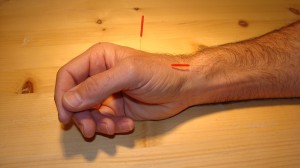As an acupuncturist, I get all kinds of questions from new patients about how acupuncture works, what I’m doing during my treatments, and how long will it take to get better. However, I probably get more questions about acupuncture needles from first-timers than any other topic.
One of the most frequent questions (and interestingly, this is usually from men) is how many needles have I used on them. This is an easy one; I just stop and count them up. I’m also asked a more difficult question, which is how deep the needles are inserted. This is not as easy to answer because there are a number of variables to consider, including:
-Where on the body the needle is being inserted. Essentially, a needle going into your hand just can’t go as deep as a needle going into your butt. Places that have a lot of muscle or fat lend themselves to deeper insertion; sometimes up to two or three inches. However, needles going into places like hands, feet, ears, wrists, etc. that aren’t as fleshy, may only go in a millimeter or two (less than a quarter of an inch).
two or three inches. However, needles going into places like hands, feet, ears, wrists, etc. that aren’t as fleshy, may only go in a millimeter or two (less than a quarter of an inch).
-The style of acupuncture being practiced also makes a difference. If I’m doing auricular (ear) acupuncture, I’m using tiny, short ear needles. Also, Japanese-style and Korean hand acupuncture are characterized by a shallower insertion depth than Chinese-style.
-The angle of insertion also determines depth. Basically, any needle inserted at an oblique angle won’t be as deep as a needle inserted straight in. For example, in wrist acupuncture the needles are inserted just under the skin of the wrist, but the needle is threaded without going any deeper for an inch or two. (This kind of acupuncture is completely painless, and if the patient feels anything, it’s being done incorrectly.)
-The constitution of the patient also determines how deep the needles go. A busy Type A executive with the throbbing forehead vein usually needs deep needling in order to get better. In contrast, a depleted patient with a chronic illness usually does better with fewer needles inserted shallowly.
-The condition being treated is also a factor in not only where the needles go, but how deeply they’re inserted. For example, a patient being treated for sciatica usually will be needled deeply in the butt in order to help their sciatic nerve calm down. They would then be needled along the pathway of the nerve (and the pain), but usually not as deeply. In contrast, when I’m treating someone with arthritis in their hands, I will use small gauge needles and insert shallowly on or near the points of their pain.
-Last, but certainly not least, safety plays a huge role in needle depth. Needling around the head, neck, spine, and over internal organs demands care on the part of the practitioner. Licensed acupuncturists spend years studying correct needle depth and placement, and are well-aware of what is underneath an area in which a needle is being inserted.
So what do I tell my patients who ask just how deep those needles are being placed? I answer that it all depends…




This is great education for anyone who seeks acupuncture medication as an alternative.